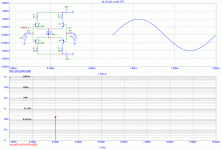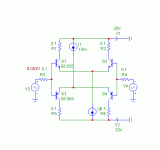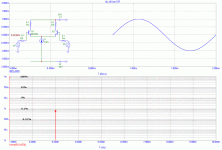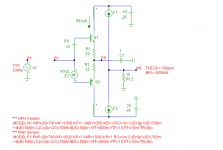All else being equal, higher open loop bandwidth is better, BUT the oscillator driver I designed was made for instrumentation, NOT audio. I would not recommend that approach in general. This is because I had to make a more conventional design, rather than my traditional designs, and I think that my complementary differential designs sound better for audio.
john curl said:PMA, I do have your model running on Nelson's PC.
Good news. We may try the complementary differential BJT as well. Most probably the inherent higher non-linearity of BJT transconductance transfer function would bring higher distortion, compared to JFETs.
PMA said:As expected, simple differential BJT has higher distortion, according to necessity of higher input voltage to get same output current.
Hi Pavel,
But not a CFB input stage with BJTs. For minimal distortion RE = 0.5 * VT / Ie. (VT is the thermal voltage, ~26mV)
Cheers,
Edmond.
Attachments
Edmond Stuart said:
Hi Pavel,
But not a CFB input stage with BJTs. For minimal distortion RE = 0.5 * VT / Ie. (VT is the thermal voltage, ~26mV)
Cheers,
Edmond.
Hi Edmond
To beat jfet linearity with BJT's, we do not need to resort to a CFB input stage, we just need emitter degeneration
A good on-line reference:
http://www.dself.dsl.pipex.com/ampins/dipa/dipa.htm
5.1 DISTORTION 1. Input Pair Non-linearity
Cheers,
Glen
G.Kleinschmidt said:
To beat jfet linearity with BJT's, we do not need to resort to a CFB input stage, we just need emitter degeneration
Which happens to be (local) current feedback.
GRollins said:
Hmmm. If you use a lot of feedback, your karma gets balanced by a forward upper midrange/lower treble and a loss of the lower level detail stuff like hall ambience and the tiny details that tend to get overlooked by people who don't listen carefully.
An a priori statement about how ANY amplifier will sound is not provable, but that’s not the point. After all these years virtually all comments along these lines remains anecdotal. You and Charles remain polite and intelligent in your comments but I see some good stuff being done by others and I feel they’re being “gently insulted” at times mainly by the implication that they “just don’t listen carefully” or “don’t know how live music sounds”. Another thing that has been pointed out before is that virtually every source available to anyone has gone through not one but many high feedback amplifiers so apparently this “effect” isn’t permanent? I’m having a public and private discussion elsewhere with the designer of the Calrec Soundfield microphone, very highly regarded by many professional recording engineers and musicians. The key to it’s performance?, gobs of GNF, 5532’s with feedback all the way to the capsule.
Yes, that’s the issue I have trouble with. The “detail” is lost how is it found again, without of course making it up?
GRollins said:
build a tube circuit and turn the feedback up and down with a knob. The sonic cost/benefit scenarios are the same in a tube circuit as they are in solid state.
Grey
I read the Curl, Jung, et al letters and I agree that Bob was actually a little too emotional, but the most important thing he said was on the feedback issues. The first letter had IMO some fundamental misconceptions about feedback. Off the top of my head I have a hard time with just "turning the feedback up and down". As Bob pointed out you need to start out with a whole set of design parameters based on your goals. I use two zero feedback stages for my phone preamp, I certainly have no problem with no feedback.
scott wurcer said:
An a priori statement about how ANY amplifier will sound is not provable, but that’s not the point. After all these years virtually all comments along these lines remains anecdotal. You and Charles remain polite and intelligent in your comments but I see some good stuff being done by others and I feel they’re being “gently insulted” at times mainly by the implication that they “just don’t listen carefully” or “don’t know how live music sounds”. Another thing that has been pointed out before is that virtually every source available to anyone has gone through not one but many high feedback amplifiers so apparently this “effect” isn’t permanent? I’m having a public and private discussion elsewhere with the designer of the Calrec Soundfield microphone, very highly regarded by many professional recording engineers and musicians. The key to it’s performance?, gobs of GNF, 5532’s with feedback all the way to the capsule.
Yes, that’s the issue I have trouble with. The “detail” is lost how is it found again, without of course making it up?
Let's take something really gross, like clipping. You, I, and every member of this board who's ever heard clipping would agree that turning a normal stereo amplifier (class A, AB, or B) into a crude class C amplifier isn't a good thing. But does every amplifier sound the same when it clips? No, not really. Differences in recovery time and so forth allow some circuits to clip more gracefully than others. So is it fair to generalize about the sound of clipping amplifiers? To me, yes. The sounds heard from any ten clipping amps are more similar than they are different. Likewise the sound of heavy NFB usage. Does every high NFB amplifier sound identical? Of course not, but the similarities outweigh the differences.
The 'after all these years' portion of your statement ignores audio history. Those who listened said for years that absolute phase was audible, yet they were scoffed at and ridiculed. While you can see that the phase is inverted on an oscilloscope, it doesn't show up in any distortion measurement. Yet it was finally proven that people can detect absolute phase. Did the length of time that it was on the table as an unproven and contentious assertion matter? Not a bit. All people had to do was sit and listen (bass drums have more impact when the phase is correct), but they couldn't be bothered to do so. Eventually someone got around to demonstrating that it was audible, to which some said, "Wow, who woulda thunk it?" but others just rolled their eyes and said, "Well, duh!"
Your statement regarding feedback is a common one, but it's based on a misconception. Damage to the original signal isn't a binary on/off process, it's a question of incremental deterioration. Every step in the recording chain matters. The ones before the recording reaches your house are not under your control, and, yes, there are scads of opamps and compressors and various things that wouldn't be there in a perfect world. But once you get control of the signal, the objective is to treat it with as much respect as possible because, as you note, once information is gone you can't get it back.
Some recordings are clearly better than others. Why? Is it because they used more feedback, more opamps, and more parts in the signal path? Or less? It's not always an easy question to answer, particularly in the case of pop music because there are so many things in the signal path already, but if you take an average of the recording philosophies, you'll find that there's a clear trend.
Grey
The sounds heard from any ten clipping amps are more similar than they are different.
Couldn't disagree more. An amp that clips uneventfully will sound VERY different than an amp that has sticking or blocking behavior.
PMA, you changed the current sources to something more realistic, BUT if you add a 10 ohm resistor from the top emitter pair to the complementary emitter pair and adjust the current sources, to get the same current in the transistors, what happens? A big capacitor would do as well.
The designer of the Calrec mike is dead, I am pretty sure. Are you talking to his associate, Peter Craven? If not, you are talking to an impostor.
In any case, 5532's are marginal and AD797's, or AD825's or some such would be better, for sure. Everyone knows that. People are just cheap and indifferent.
In any case, 5532's are marginal and AD797's, or AD825's or some such would be better, for sure. Everyone knows that. People are just cheap and indifferent.
Edmond's anti clipping mechanism is very interesting. I feel (haven't built it yet) it will allow merit of tons of feedback without the nasty clipping (signal squaring) sound.The sounds heard from any ten clipping amps are more similar than they are different.
- Status
- Not open for further replies.
- Home
- Amplifiers
- Solid State
- John Curl's Blowtorch preamplifier



